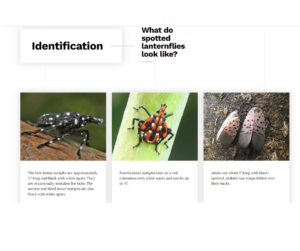In recent years, a tiny insect has been wreaking havoc in various regions across the
globe. Either by walking through your backyard or engaging in social media, you are
likely to be aware of the arrival of the spotted lanternfly, an invasive species of insect
that can pose a serious threat to some of our local crops and trees. Initially found in the
United States in 2014 in Pennsylvania, the spotted lanternfly is now pervasive
throughout the lower Hudson Valley region and south, including New York City and New
Jersey. This miniature menace is none other than the spotted lanternfly, scientifically
known as the Lycorma Delicatula. While its name might sound innocuous, its impact on
agriculture and biodiversity is far from benign.
The spotted lanternfly measures about an inch long with vibrant red wings and black
spots, but its beauty belies the devastation it causes. They are weak fliers, but move
primarily with a swift and powerful jump. This invasive insect is known for its voracious
appetite, particularly for plants like grapes, hops, fruit trees, and hardwoods, making it a
major concern for agriculture.
The spotted lanternfly uses a specialized mouthpart that is able to pierce and draw sap
from over 70 different plant species. They have a strong preference to feed on the Tree
of Heaven (another invasive species), but they are also inclined to target economically
important plants including grapevines, apple trees, maple trees, black walnut, birch,
willow, and other trees. While most adult trees are able to handle the stress caused by
extensive lanternfly feeding, an infestation significantly stresses the plants which can
lead to disease and death. Beyond the monetary impact, this pest also poses a risk to
local ecosystems and disrupts the delicate balance of biodiversity.
In addition to its impact on plants, the spotted lanternfly can also affect honeybees and
other beneficial insects. When these insects feed on the sticky honeydew secreted by
the lanternflies, it can lead to reduced pollination and hinder natural pest control
mechanisms, further exacerbating the problem.
There are a few ways you can try to help control their spread, the most effective is to
destroy these egg masses as they begin to appear in the coming weeks. Eggs can be
found on any hard surface, including plastic, wood, and metal. Check for the egg masses on tree trunks, branches, rocks, lawn furniture, and really anything that’s outside. The egg masses are often found on the underside of branches or objects and vary in size, but are typically about 1 1/2″ long and and 3/4″ wide and look like grayish splotches of mud or putty. Scraping the mass with a knife or any flat edged tool is an easy way to remove it. The eggs can be killed by placing them in a ziplock bag with
rubbing alcohol or hand sanitizer or by smashing them thoroughly.
Other methods to eradicate the insects include placing sticky and circle traps onto tree
trunks, but these can capture beneficial insects and other wildlife. Again, it is important
to remember that most landscaping and ornamental trees will not be jeopardized.
However, in the event that a tree appears to be in significant distress, traps and
pesticides can be used. A detailed overview of these methods and a list of approved
pesticides can be found on the Cornell Cooperative Extension website below and
search “spotted lanternfly”: https://cals.cornell.edu/cornell-cooperative-extension
The bad news is that it looks like the spotted lanternfly will be visiting us for quite a long
time, but the good news is the damage they inflict isn’t as extensive as many originally
feared. Chances are good that your trees and landscaping will be just fine, but the
insect does pose an immediate threat to some important crops in our area. With that in
mind, please make an effort to remove any egg masses you find, and check your
vehicle for any potential hitchhikers before leaving on a trip to an area where lanternflies
are not currently established.




